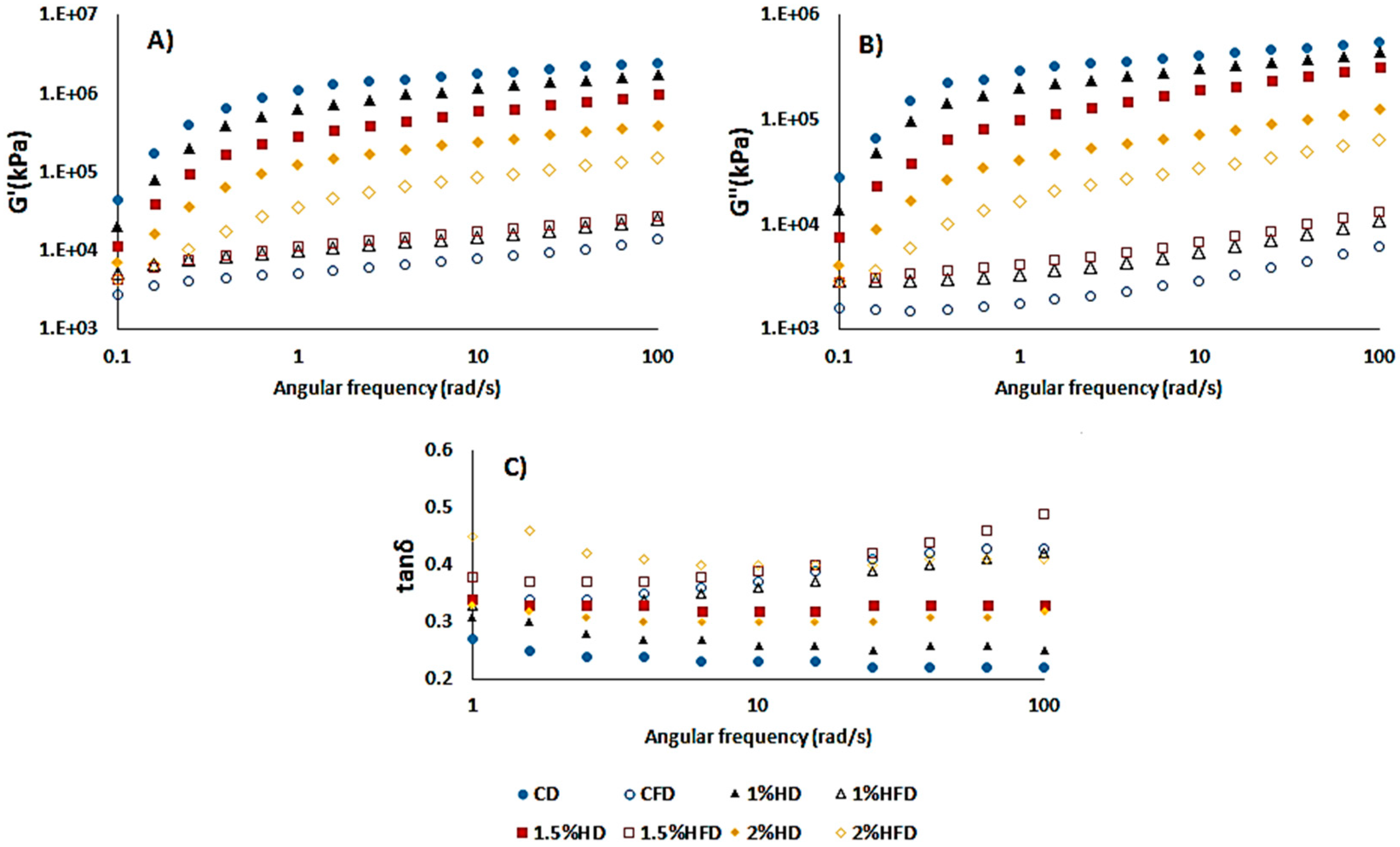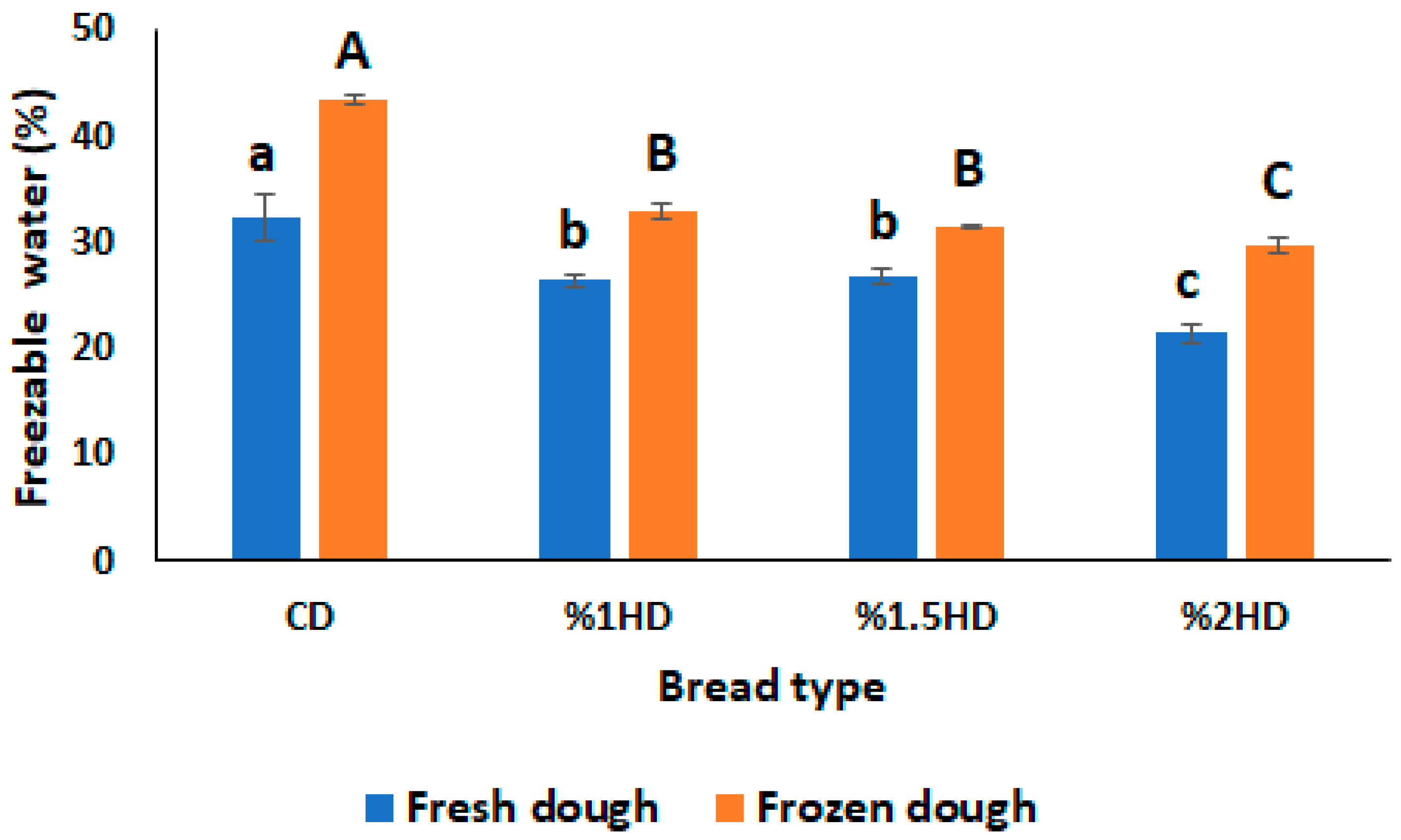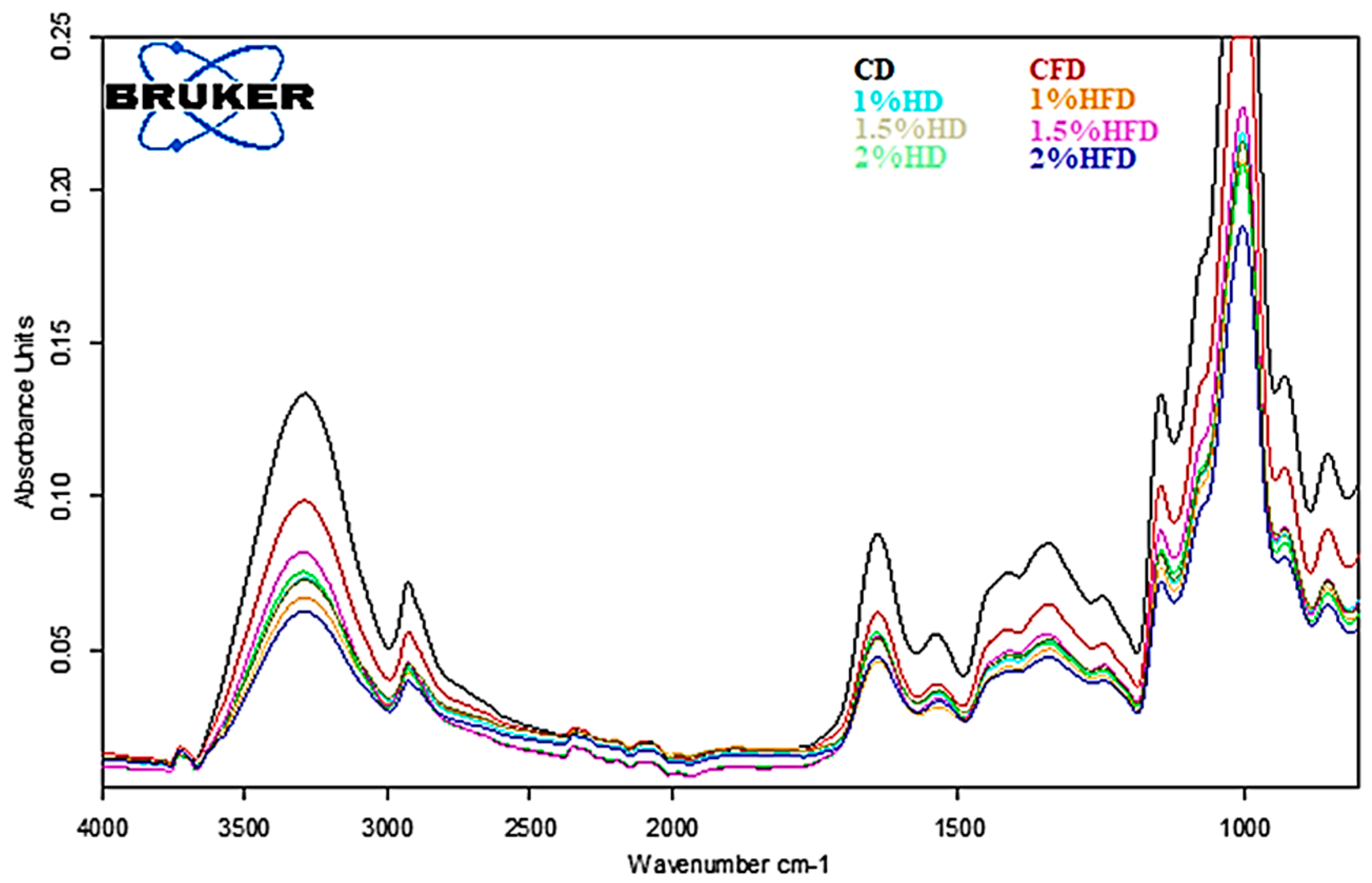Effects of Casein Hydrolysate Prepared with Savinase on the Quality of Bread Made by Frozen Dough
Abstract
:1. Introduction
2. Materials and Methods
2.1. Materials
2.2. Preparation of Casein Hydrolysate
2.3. Preparation of Bread Dough and Baking
2.4. Rheological Measurements
2.5. Freezable Water (FW) Content
2.6. Sodium Dodecyl Sulfate–Polyacrylamide Gel Electrophoresis (SDS-PAGE) Analysis
2.7. Fourier Transform Infrared Spectroscopy (FT-IR)
2.8. Determination of Bread Quality
2.8.1. Specific Volume (SV)
2.8.2. Texture
2.8.3. Color
2.9. Statistical Analysis
3. Results and Discussion
3.1. Dynamic Rheological Properties of Dough
3.2. SDS-PAGE Analysis
3.3. Freezable Water Content
3.4. Analysis of Secondary Structures of Protein
3.5. Specific Volume, Hardness and Color of Bread
4. Conclusions
Author Contributions
Funding
Data Availability Statement
Conflicts of Interest
References
- Gani, A.; Broadway, A.A.; Masoodi, F.A.; Wani, A.A.; Maqsood, S.; Ashwar, B.A.; Shah, A.; Rather, S.A.; Gani, A. Enzymatic hydrolysis of whey and casein protein-effect on functional, rheological, textural and sensory properties of breads. J. Food Sci. Technol. 2015, 52, 7697–7709. [Google Scholar] [CrossRef] [PubMed]
- Abd El-Salam, M.H.; El-Shibiny, S. Preparation, properties, and uses of enzymatic milk protein hydrolysates. Crit. Rev. Food Sci. Nutr. 2017, 57, 1119–1132. [Google Scholar] [CrossRef]
- Ryan, G.; Nongonierma, A.B.; O’Regan, J.; FitzGerald, R.J. Functional properties of bovine milk protein isolate and associated enzymatic hydrolysates. Int. Dairy J. 2018, 81, 113–121. [Google Scholar] [CrossRef]
- Tang, T.; Wu, N.; Tang, S.; Xiao, N.; Jiang, Y.; Tu, Y.; Xu, M. Industrial application of protein hydrolysates in food. J. Agric. Food Chem. 2023, 71, 1788–1801. [Google Scholar] [CrossRef]
- Hidalgo, M.E.; Côrrea, A.P.F.; Canales, M.M.; Daroit, D.J.; Brandelli, A.; Risso, P. Biological and physicochemical properties of bovine sodium caseinate hydrolysates obtained by a bacterial protease preparation. Food Hydrocoll. 2015, 43, 510–520. [Google Scholar] [CrossRef]
- Clemente, A. Enzymatic protein hydrolysates in human nutrition. Trends Food Sci. Technol. 2000, 11, 254–262. [Google Scholar] [CrossRef]
- Bekiroglu, H.; Bozkurt, F.; Karadag, A.; Ahhmed, A.M.; Sagdic, O. The effects of different protease treatments on the techno-functional, structural, and bioactive properties of bovine casein. Prep. Biochem. Biotechnol. 2022, 52, 1097–1108. [Google Scholar] [CrossRef]
- Phimolsiripol, Y.; Siripatrawan, U.; Tulyathan, V.; Cleland, D.J. Effects of freezing and temperature fluctuations during frozen storage on frozen dough and bread quality. J. Food Eng. 2008, 84, 48–56. [Google Scholar] [CrossRef]
- Berglund, P.T.; Shelton, D.R.; Freeman, T.P. by Duration of Frozen Storage and Freeze-Thaw Cycles’. Cereal Chem. 1991, 68, 105–107. [Google Scholar]
- Naito, S.; Fukami, S.; Mizokami, Y.; Ishida, N.; Takano, H.; Koizumi, M.; Kano, H. Effect of freeze-thaw cycles on the gluten fibrils and crumb grain structures of breads made from frozen doughs. Cereal Chem. 2004, 81, 80–86. [Google Scholar] [CrossRef]
- Aibara, S.; Nishimura, K.; Esaki, K. Effects of shortening on the loaf volume of frozen dough bread. Food Sci. Biotechnol. 2001, 10, 54–61. [Google Scholar]
- Shon, J.; Yun, Y.; Shin, M.; Chin, K.B.; Eun, J.B. Effects of milk proteins and gums on quality of bread made from frozen dough. J. Sci. Food Agric. 2009, 89, 1407–1415. [Google Scholar] [CrossRef]
- Yu, W.; Xu, D.; Zhang, H.; Guo, L.; Hong, T.; Zhang, W.; Jin, Y.; Xu, X. Effect of pigskin gelatin on baking, structural and thermal properties of frozen dough: Comprehensive studies on alteration of gluten network. Food Hydrocoll. 2020, 102, 105591. [Google Scholar] [CrossRef]
- Chen, J.; Xiao, J.; Tu, J.; Yu, L.; Niu, L. The alleviative effect of sweet potato protein hydrolysates on the quality deterioration of frozen dough bread in comparison to trehalose. LWT 2023, 175, 114505. [Google Scholar] [CrossRef]
- Zhou, B.; Dai, Y.; Guo, D.; Zhang, J.; Liang, H.; Li, B.; Sun, J.; Wu, J. Effect of desalted egg white and gelatin mixture system on frozen dough. Food Hydrocoll. 2022, 132, 107889. [Google Scholar] [CrossRef]
- Cao, H.; Zheng, X.; Liu, H.; Yuan, M.; Ye, T.; Wu, X.; Yin, F.; Li, Y.; Yu, J.; Xu, F. Cryo-protective effect of ice-binding peptides derived from collagen hydrolysates on the frozen dough and its ice-binding mechanisms. LWT 2020, 131, 109678. [Google Scholar] [CrossRef]
- Adler-Nissen, J. Enzymic Hydrolysis of Food Proteins; Elsevier Applied Science Publishers: Amsterdam, The Netherlands, 1986. [Google Scholar]
- Shazly, A.B.; He, Z.; Abd El-Aziz, M.; Zeng, M.; Zhang, S.; Qin, F.; Chen, J. Fractionation and identification of novel antioxidant peptides from buffalo and bovine casein hydrolysates. Food Chem. 2017, 232, 753–762. [Google Scholar] [CrossRef]
- Rao, P.S.; Mayur, A.; Harisha, N.B.; Bajaj, R.; Mann, B. Comparison of OPA and pH stat methods for measurement of degree of hydrolysis of alcalase and flavourzyme digested casein. Indian J. Dairy Sci. 2018, 71, 107–109. [Google Scholar]
- Laemmli, U.K. Cleavage of Structural Proteins during the Assembly of the Head of Bacteriophage T4. Nature 1970, 227, 680–685. [Google Scholar] [CrossRef]
- Wang, J.; Su, Y.; Jia, F.; Jin, H. Characterization of casein hydrolysates derived from enzymatic hydrolysis. Chem. Cent. J. 2013, 7, 62. [Google Scholar] [CrossRef] [PubMed]
- Zhu, T.W.; Zhang, X.; Li, B.; Wu, H. Effect of interesterified blend-based fast-frozen special fat on the physical properties and microstructure of frozen dough. Food Chem. 2019, 272, 76–83. [Google Scholar] [CrossRef] [PubMed]
- Khatkar, B.S.; Bell, A.E.; Schofield, J.D. The dynamic rheological properties of glutens and gluten sub-fractions from wheats of good and poor bread making quality. J. Cereal Sci. 1995, 22, 29–44. [Google Scholar] [CrossRef]
- Lu, P.; Guo, J.; Fan, J.; Wang, P.; Yan, X. Combined effect of konjac glucomannan addition and ultrasound treatment on the physical and physicochemical properties of frozen dough. Food Chem. 2023, 411, 135516. [Google Scholar] [CrossRef] [PubMed]
- Wang, X.Y.; Guo, X.N.; Zhu, K.X. Polymerization of wheat gluten and the changes of glutenin macropolymer (GMP) during the production of Chinese steamed bread. Food Chem. 2016, 201, 275–283. [Google Scholar] [CrossRef]
- Wang, Q.; Li, Y.; Sun, F.; Li, X.; Wang, P.; Sun, J.; Zeng, J.; Wang, C.; Hu, W.; Chang, J.; et al. Tannins improve dough mixing properties through affecting physicochemical and structural properties of wheat gluten proteins. Food Res. Int. 2015, 69, 64–71. [Google Scholar] [CrossRef]
- Wang, P.; Lee, T.C.; Xu, X.; Jin, Z. The contribution of glutenin macropolymer depolymerization to the deterioration of frozen steamed bread dough quality. Food Chem. 2016, 211, 27–33. [Google Scholar] [CrossRef]
- Wang, P.; Chen, H.; Mohanad, B.; Xu, L.; Ning, Y.; Xu, J.; Wu, F.; Yang, N.; Jin, Z.; Xu, X. Effect of frozen storage on physico-chemistry of wheat gluten proteins: Studies on gluten-, glutenin-and gliadin-rich fractions. Food Hydrocoll. 2014, 39, 187–194. [Google Scholar] [CrossRef]
- Lou, X.; Yue, C.; Luo, D.; Li, P.; Zhao, Y.; Xu, Y.; Wang, L.; Bai, Z. Effects of natural inulin on the rheological, physicochemical and structural properties of frozen dough during frozen storage and its mechanism. LWT 2023, 184, 114973. [Google Scholar] [CrossRef]
- Yang, Z.; Xu, D.; Zhou, H.; Wu, F.; Xu, X. Rheological, microstructure and mixing behaviors of frozen dough reconstituted by wheat starch and gluten. Int. J. Biol. Macromol. 2022, 212, 517–526. [Google Scholar] [CrossRef]
- Mao, X.; Liu, Z.; Ma, J.; Pang, H.; Zhang, F. Characterization of a novel β-helix antifreeze protein from the desert beetle Anatolica polita. Cryobiology 2011, 62, 91–99. [Google Scholar] [CrossRef]
- Sharadanant, R.; Khan, K. Effect of hydrophilic gums on the quality of frozen dough: II. Bread characteristics. Cereal Chem. 2003, 80, 773–780. [Google Scholar] [CrossRef]





| Storage Time | Samples | β-Sheets | β-Turns | α-Helices | Random Coils |
|---|---|---|---|---|---|
| CD | 12.42 ± 1.92 aA | 28.72 ± 1.82 aB | 49.46 ± 3.13 aA | 9.71 ± 1.34 bA | |
| Day 0 | 1% HD | 7.75 ± 1.05 bA | 23.12 ± 1.51 bB | 33.08 ± 2.87 bA | 36.05 ± 2.80 aA |
| 1.5% HD | 15.04 ± 1.12 aB | 17.38 ± 1.17 cA | 35.10 ± 2.63 bA | 32.48 ± 3.35 aA | |
| 2% HD | 14.14 ± 2.11 aA | 19.75 ± 1.43 bcA | 32.61 ± 2.64 bA | 34.00 ± 2.83 aA | |
| CFD | 16.30 ± 1.29 bA | 41.22 ± 1.94 aA | 35.53 ± 1.47 aB | 6.45 ± 1.85 bA | |
| Day 28 | 1% HFD | 10.24 ± 1.61 cA | 33.74 ± 1.82 bA | 22.14 ± 2.81 bA | 33.88 ± 1.58 aA |
| 1.5% HFD | 23.06 ± 1.44 aA | 21.39 ± 2.19 cA | 28.05 ± 2.72 bA | 27.5 ± 3.54 aA | |
| 2% HFD | 19.73 ± 1.53 abA | 24.8 ± 2.33 cA | 24.24 ± 1.30 bA | 31.23 ± 4.40 aA |
| Storage Time | Samples | Crust | Crumb | ||||||
|---|---|---|---|---|---|---|---|---|---|
| L* | a* | b* | ΔE | L* | a* | b* | ΔE | ||
| CD | 58.58 ± 3.59 aA | 11.83 ± 0.84 aA | 29.34 ± 1.12 aA | - | 70.44 ± 2.01 aA | −0.01 ± 0.27 aA | 14.81 ± 0.67 cB | - | |
| 1% HD | 55.78 ± 2.71 abA | 12.87 ± 0.70 aA | 31.58 ± 1.53 aA | 5.60 ± 3.35 aA | 71.45 ± 1.10 aA | 0.06 ± 0.05 aA | 16.46 ± 0.26 abA | 2.99 ± 1.15 aA | |
| Day 0 | 1.5% HD | 52.37 ± 2.94 bcA | 13.50 ± 1.23 aA | 31.99 ± 0.95 aA | 7.09 ± 2.14 aA | 72.83 ± 2.16 aA | −0.04 ± 0.13 aA | 16.27 ± 0.48 bA | 4.07 ± 2.21 aA |
| 2% HD | 49.93 ± 3.67 cA | 13.62 ± 1.24 aA | 28.40 ± 1.67 aA | 9.31 ± 6.17 aA | 72.27 ± 0.78 aA | 0.05 ± 0.09 aA | 17.13 ± 0.51 aA | 3.45 ± 1.44 aA | |
| CFD | 58.32 ± 0.77 aA | 11.13 ± 0.61 aA | 24.73 ± 1.92 aB | 6.09 ± 1.91 b | 63.76 ± 2.50 bB | 0.02 ± 0.14 aA | 16.25 ± 0.83 aA | 6.92 ± 1.53 aA | |
| Day 28 | 1% HFD | 57.06 ± 2.55 abA | 12.31 ± 1.15 aA | 24.47 ± 1.81 aB | 5.70 ± 2.11 bA | 67.90 ± 1.69 aB | 0.12 ± 0.23 aA | 16.79 ± 1.07 aA | 3.46 ± 1.29 bA |
| 1.5% HFD | 55.30 ± 0.71 bA | 11.90 ± 2.08 aA | 23.01 ± 1.15 aB | 8.13 ± 1.84 abA | 67.48 ± 3.43 abB | 0.22 ± 0.26 aA | 16.76 ± 0.29 aA | 3.96 ± 2.01 bA | |
| 2% HFD | 52.67 ± 1.39 cA | 11.83 ± 0.81 aA | 22.83 ± 4.07 aB | 9.84 ± 2.72 aA | 67.90 ± 0.90 aB | 0.30 ± 0.03 aA | 16.80 ± 0.52 aA | 3.66 ± 1.30 bA | |
Disclaimer/Publisher’s Note: The statements, opinions and data contained in all publications are solely those of the individual author(s) and contributor(s) and not of MDPI and/or the editor(s). MDPI and/or the editor(s) disclaim responsibility for any injury to people or property resulting from any ideas, methods, instructions or products referred to in the content. |
© 2023 by the authors. Licensee MDPI, Basel, Switzerland. This article is an open access article distributed under the terms and conditions of the Creative Commons Attribution (CC BY) license (https://creativecommons.org/licenses/by/4.0/).
Share and Cite
Bekiroglu, H.; Ozulku, G.; Sagdic, O. Effects of Casein Hydrolysate Prepared with Savinase on the Quality of Bread Made by Frozen Dough. Foods 2023, 12, 3845. https://doi.org/10.3390/foods12203845
Bekiroglu H, Ozulku G, Sagdic O. Effects of Casein Hydrolysate Prepared with Savinase on the Quality of Bread Made by Frozen Dough. Foods. 2023; 12(20):3845. https://doi.org/10.3390/foods12203845
Chicago/Turabian StyleBekiroglu, Hatice, Gorkem Ozulku, and Osman Sagdic. 2023. "Effects of Casein Hydrolysate Prepared with Savinase on the Quality of Bread Made by Frozen Dough" Foods 12, no. 20: 3845. https://doi.org/10.3390/foods12203845






